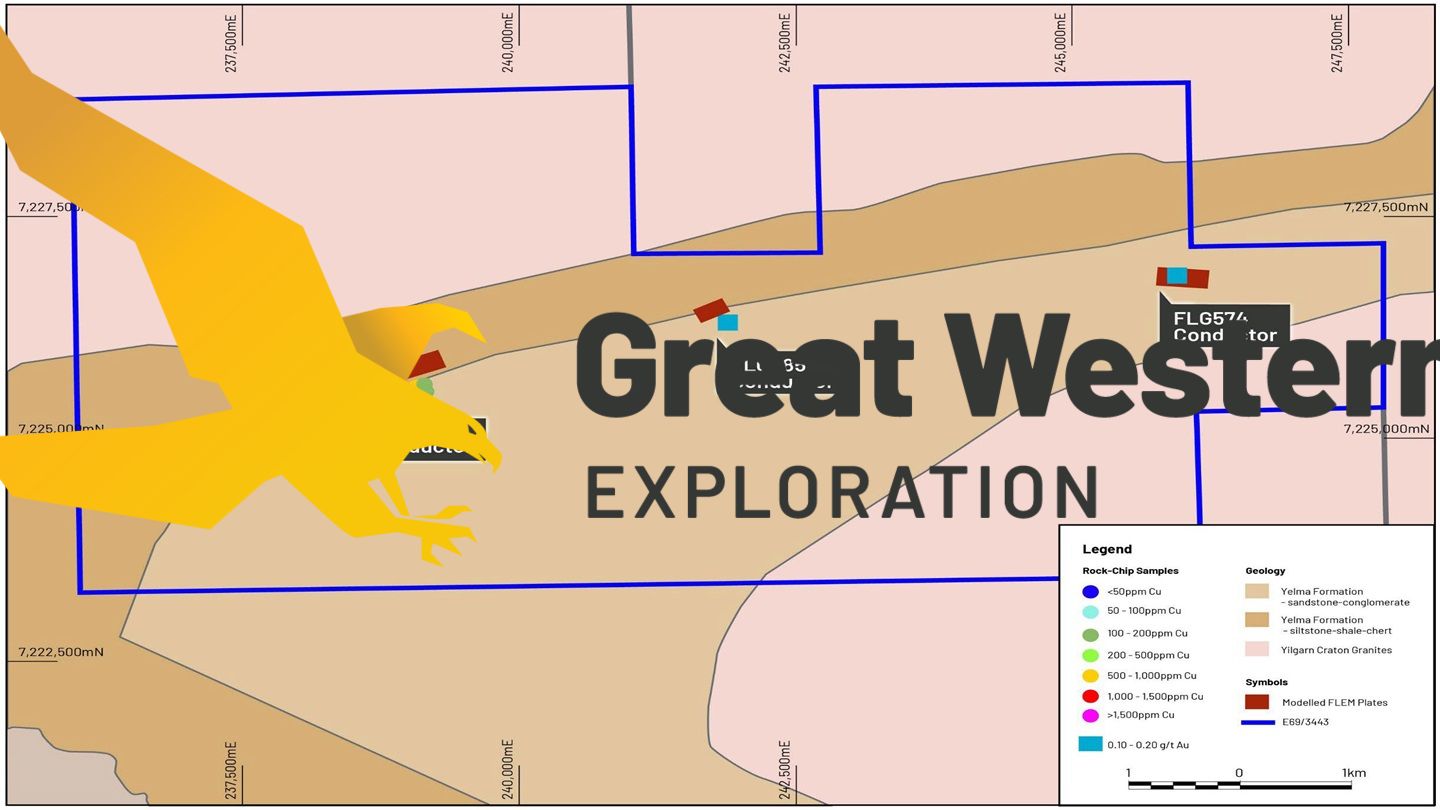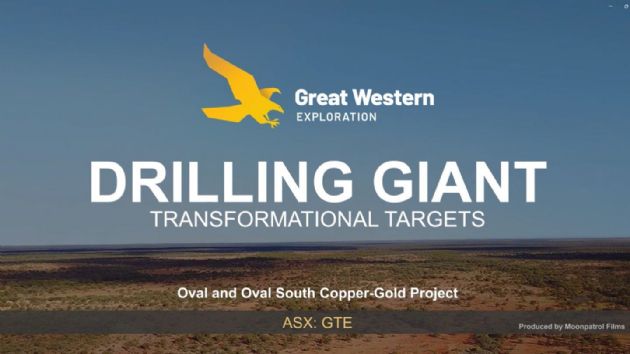Field Work Identifies Highly Prospective Copper-Gold Target Within the Yerrida North Project
 Juggernaut VHMS Copper-Gold Target
Juggernaut VHMS Copper-Gold Target
Perth, Oct 8, 2024 AEST (ABN Newswire) - Great Western Exploration Limited ( ASX:GTE) is pleased to announce the identification of Juggernaut, a highly prospective Volcanic Massive Sulphide Mineralisation (VHMS) copper-gold target, with potential for copper-lead-zinc-silver-gold mineralisation to be defined similar to the nearby DeGrussa and Monty Copper-Gold Deposits.
ASX:GTE) is pleased to announce the identification of Juggernaut, a highly prospective Volcanic Massive Sulphide Mineralisation (VHMS) copper-gold target, with potential for copper-lead-zinc-silver-gold mineralisation to be defined similar to the nearby DeGrussa and Monty Copper-Gold Deposits.
Key Points
- Highly prospective Volcanic Hosted Massive Sulphide (VHMS) copper-gold target, Juggernaut, has been identified within the Yerrida North Project, located 70kms south-east of the DeGrussa and Monty Copper-Gold Deposits.
- The Juggernaut VHMS copper-gold target was defined by numerous field work programmes, that included geological mapping, surface sampling, and modelling.
- Juggernaut is defined by a zoned lead-zinc to copper geochemical anomaly, with geological mapping defining sedimentary and volcanic rocks, indicative of a deep seafloor environment with syngenetic volcanism, with structural modelling having determined the rock units at Juggernaut were formed within a rift structural setting.
- The high prospectivity of the Juggernaut copper-gold target is evidenced by the confluence of coincident attributes, including geochemical anomalism, mapped geological units and associated textures, and modelled structural regime. These attributes are interpreted by the Company to have high potential for a VHMS type mineral system to be defined, similar to DeGrussa in the nearby Bryah Basin.
- Great Western is commencing preparations for drilling this exciting copper-gold target, with a heritage clearance indicatively scheduled for November 2024.
The Juggernaut target is within the Company's Yerrida North Project, located on the western portion of the Yerrida Basin, and located approximately 800km north-east of Perth and 70kms south-east of the DeGrussa and Monty CuAu VHMS deposits, shown in Figure 1*.
Review of legacy lag and soil sampling data completed by Xstrata in the mid to late 2000s identified a large lead-zinc lag soil anomaly that was not drill tested. Great Western completed considerable additional lag soil sampling west and north of this identified zone of anomalism, that extended the lead-zinc anomaly footprint and, importantly, identified copper anomalism to the north (Figure 2*). The two anomalous zones were interpreted to represent one broad and zoned geochemical anomaly, indicative of a number of types of mineralisation systems (for example: VHMS, Cobar type).
Field mapping and rock-chip sampling was then undertaken to ground truth the soil anomalism, with geological units mapped including sedimentary rocks (siltstones, sandstones, cherts/exhalates) and basaltic volcanic rocks (Figure 3*), of the Killara Formation. The basaltic units included pillow and pepperite textures (Figure 4*), representing sub aqueous deposition. The association between sedimentary and volcanic rocks suggest a deep seafloor geological environment with syngenetic volcanic activity, particularly evident by pillow and pepperite textures within the basaltic units.
The Killara Formation has been determined by previous studies to be the equivalent of the DeGrussa Formation, host to the DeGrussa and Monty copper-gold VHMS Deposits in the adjacent Byrah Basin. The Killara Formation is thought to be of similar age with similar types of sedimentary and volcanic rock units of the DeGrussa Formation (Hawke et al., 2015).
Rock-chip sampling completed at Juggernaut recorded significant results that included: silver (ranging between 0.24g/t to 20g/t), lead (range: 145ppm - 4,460ppm), zinc (range: 682ppm - 4,850ppm), and copper (range: 427ppm - 850ppm).
The Company interprets that the zoned lag soil lead-zinc and copper anomalism together with the mapped geological association between sedimentary and volcanic rocks suggests a deep seafloor geological environment, represents a highly prospective VHMS mineralisation system at Juggernaut. The Company believes the mapped geological units at surface represent a position outboard from a volcanic vent, with potential at depth to define copper mineralisation below a black smoker position of a VHMS system, as shown in Figure 6*. The association between the mapped fault and interpreted fault structures and lag soil copper anomalism is considered potential leakage of mineralisation at depth.
Great Western is commencing preparations for drilling this exciting copper-gold target, with a heritage clearance indicatively scheduled for November 2024.
*To view tables and figures, please visit:
https://abnnewswire.net/lnk/5PI1J56Z
About Great Western Exploration Limited
 Great Western Exploration (ASX:GTE) is an explorer with a world class, large land position in prolific regions of Western Australia. Great Western's tenements have been under or virtually unexplored. Numerous work programmes across multiple projects are underway and the Company is well-funded with a tight capital structure, providing leverage to exploration success.
Great Western Exploration (ASX:GTE) is an explorer with a world class, large land position in prolific regions of Western Australia. Great Western's tenements have been under or virtually unexplored. Numerous work programmes across multiple projects are underway and the Company is well-funded with a tight capital structure, providing leverage to exploration success.


![abnnewswire.com]()
Related Companies
Social Media
Share this Article

 ASX:GTE) is pleased to announce the identification of Juggernaut, a highly prospective Volcanic Massive Sulphide Mineralisation (VHMS) copper-gold target, with potential for copper-lead-zinc-silver-gold mineralisation to be defined similar to the nearby DeGrussa and Monty Copper-Gold Deposits.
ASX:GTE) is pleased to announce the identification of Juggernaut, a highly prospective Volcanic Massive Sulphide Mineralisation (VHMS) copper-gold target, with potential for copper-lead-zinc-silver-gold mineralisation to be defined similar to the nearby DeGrussa and Monty Copper-Gold Deposits.  Great Western Exploration (ASX:GTE) is an explorer with a world class, large land position in prolific regions of Western Australia. Great Western's tenements have been under or virtually unexplored. Numerous work programmes across multiple projects are underway and the Company is well-funded with a tight capital structure, providing leverage to exploration success.
Great Western Exploration (ASX:GTE) is an explorer with a world class, large land position in prolific regions of Western Australia. Great Western's tenements have been under or virtually unexplored. Numerous work programmes across multiple projects are underway and the Company is well-funded with a tight capital structure, providing leverage to exploration success.











